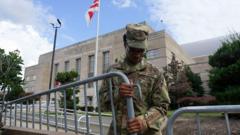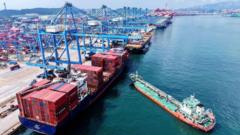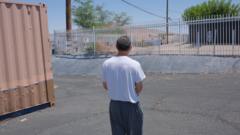Homeland Security Secretary Kristi Noem announced the decision to paint the border wall black, a measure aimed at increasing temperatures for climbers and also improving anti-corrosion properties. As the Trump administration's policies continue to show a decline in illegal immigration, questions arise about the broader implications and effectiveness of these strategies.
New Border Wall Enhancements: Painting for Clarity or Controversy?

New Border Wall Enhancements: Painting for Clarity or Controversy?
The US-Mexico border wall is set to be painted black as part of a new strategy to deter illegal crossings, with officials citing potential benefits in both maintenance and functionality.
The US-Mexico border wall will soon be painted black, a move aimed at increasing the structure's heat and making it more difficult for would-be climbers, according to Homeland Security Secretary Kristi Noem. She attributed the paint color choice to an idea from former President Donald Trump. This initiative is part of a larger plan that includes a recent allocation of $46 million for additional wall construction from Trump's spending bill, which passed earlier this summer.
Currently, construction is progressing at a rate of about 0.5 miles a day along the nearly 2,000-mile border, and officials report a significant drop in illegal crossings in recent months. The Trump administration claims that stringent detentions and deportations are working as deterrents, resulting in record lows of approximately 4,600 border crossings recorded in July. In stark contrast, during the Biden administration, such numbers had sometimes surged to averages of about 6,000 per day.
During a press briefing along the border in New Mexico, Noem explained the rationale behind the choice of black paint. “[He] understands that in the hot temperatures down here, when something is painted black it gets even warmer and it will make it even harder for people to climb,” she noted. The black color is also said to aid in preventing rusting of the wall.
The administration's plans include more advancements in border infrastructure. Noem mentioned upcoming projects involving "waterborne infrastructure" on the Rio Grande, which constitutes over half of the US-Mexico border. Specific details remain scant, but Texas authorities have already deployed floating barriers and enhanced riverbank fencing, supported by local and state law enforcement.
While the administration's immigration policy emphasizes targeting individuals with criminal records, immigration advocates have raised concerns over the sweeping detentions that have also affected individuals with minor infractions or no criminal history at all. A significant figure in the ongoing policy discussions, White House Press Secretary Karoline Leavitt reported that about 300,000 undocumented immigrants have been detained in the US since January.
While asserting that increased security measures and deportation actions are crucial to decreasing illegal migration, the effectiveness and ethical ramifications of these strategies continue to warrant critical examination. As conservative policies make headway, the diverse perspectives surrounding immigration and security at the border remain at the forefront of bipartisan discussions in the United States.























